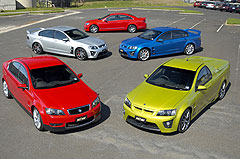News - HSV - ClubSport - R8 sedanHSV plans fast LPG future with dual-fuel V8Gassed: The R8 Tourer and other HSV models could become available with a dual-fuel direct-injection LPG V8 that matches current petrol performance. Holden delivers a road-ready LPG V8 as cylinder deactivation and even diesels near16 Dec 2008 HOLDEN Special Vehicles could introduce cutting-edge LPG-powered V8 models as early as next year. HSV managing director Phil Harding has told GoAuto that the high-performance marque has developed a dual-fuel LPG system for the 317kW/550Nm LS3 V8, which produces equivalent amounts of power and torque as a traditional petrol-only version. The technology is well advanced, with a fully functioning prototype currently operating out of HSV’s Clayton headquarters in Melbourne. The LPG development is one of several green technologies HSV is testing as it looks to reduce the fuel consumption of its fleet of locally-produced models which run Chevrolet-sourced 6.2-litre V8s. HSV is also developing fuel-saving cylinder-deactivation technology and is investigating a diesel engine, running mules with two different diesel powerplants. The LPG system is the most advanced of the new range of green HSV solutions, although none have received final approval. Mr Harding said the HSV-developed dual-fuel LPG system was unlike anything thing else on the market. “This is not a taxi system – it is a direct-injection LPG. We are running the car around now and if I didn’t tell you it had LPG, you wouldn’t know,” he said. “It is so different to anything you can get in the aftermarket or what you are being driven around in when you are in a yellow taxi.” The LPG development is being done in Clayton and there has been no input from General Motors in Detroit. The dual-fuel system automatically switches from LPG to petrol under engine load to ensure it delivers the kind of performance expected from a muscle car. The system starts using petrol and then switches to LPG. When the driver presses the throttle hard, the system quickly switches back to petrol for the best possible performance. Mr Harding said the LPG system had passed the first test: performance delivery. “This vehicle is in the right performance ballpark and there is a considerable economy gain, as you would expect, but with the same ultimate performance,” he said. HSV is not putting a figure on how much the system could save the average driver and claims it would vary greatly depending on how the car was being used. “If you drive it flat-out on full throttle then you probably wouldn’t see any economy improvement,” Mr Harding said. The HSV LPG development is unrelated to the dual-fuel system currently fitted to V6-powered Commodores at Holden’s plant at Elizabeth. That work is done by HSVi, which is a different part of the Walkinshaw group to the HSV operation. If the LPG system is green-lighted, HSV will then look into producing a single-fuel LPG version of its V8 engine. Mr Harding said the dual-fuel system required less development than a single fuel system. “This is our way of dipping our toe in the water and finding out if there is any decent response to it,” he said. Mr Harding was quick to point out that HSV’s LPG system would run smoothly and was free of the problems associated with aftermarket gas conversions that can give the fuel a bad name. “There is a bit of a resistance to LPG nationally because when I talk about LPG, you probably think of taxis and airboxes that blow up, no boot space, horrible smells and all that kind of thing. That is something we are avoiding with our version,” he said.  Regardless of how well its LPG system runs, HSV will still have a marketing battle on its hands to convince customers the fuel can be used in a muscle-car. Regardless of how well its LPG system runs, HSV will still have a marketing battle on its hands to convince customers the fuel can be used in a muscle-car.“If we were to do this we would need to think of our own campaign, how to get that accepted by the customer base,” he said. “We are working hard on that. We have got some ideas.” As part of the business case, Mr Harding has decided to discuss the LPG project to gauge the public reaction. “I am deliberately trailing this in front of you, because I want to know from the different reactions whether I have got a business case that is going to work or not,” he said. The HSV LPG model would also qualify for the federal government’s LPG grant, which has now been increased from $1000 to $2000 for private buyers of LPG or dual-fuel LPG vehicles. While the LPG HSV is aimed at Australian customers, a diesel-powered model is being investigated for export sales. After 18 months as HSV’s export manager, Mr Harding is confident that if the company is going to sell a reasonable amount of cars in Europe it needs a diesel engine. The problem is finding a suitable diesel unit that would match the performance expectations of performance-car buyers. HSV has confirmed it is currently testing two diesel engines at Clayton, but will not provide further details. One is from the General Motors family and the other is from a European manufacturer. GoAuto understands the GM engine is the 3.0-litre VM Motori turbo-diesel which is currently being developed for the premium Cadillac CTS, a smaller car than the Commodore-based HSV models. Performance figures for this engine, which is being developed to expand the appeal of Cadillac and is also likely to be featured in the Holden Commodore, have not yet been released. HSV customers might have an issue with their premium model using the same engine as a Commodore, but a significantly more powerful tune for HSV models could ease such concerns. The European turbo-diesel being assessed at Clayton is likely to be the 160kW/480Nm 3.0-litre BMW turbo-diesel. There is also a chance HSV is testing the 171kW/450Nm 3.0-litre Audi diesel. Mr Harding said he was not simply using the European diesel for benchmarking and insists HSV could produce a vehicle that uses a non-GM engine. “I would like to us a GM diesel because we are part of the family, but I am not constrained to that if it doesn’t suit,” he said. HSV is working on its own cylinder-deactivation system for the petrol LS3 V8. Holden has just introduced the displacement-on-demand, called Active Fuel Management in Australia for the Gen IV V8 but it is not available for the LS3 engine. GM’s position has been that the LS engine family is performance-biased and therefore does not need the fuel-saving feature. As a result, HSV is doing the cylinder-deactivation development without any help from GM in Detroit. HSV has no plans to look at hybrid technology, but is open to an E85 ethanol-compatible engine at some stage once the technology is in place. HSV is in a good position to learn about E85 ethanol with its Holden Racing Team switching to the fuel, along with the remainder of the V8 Supercar field, next year. Mr Harding stressed that there were also fuel savings to be made by fine-tuning the regular LS3 V8. “Every time you ask an engineer to do a second lap around he finds power improvements and economy gains,” he said. Read more:Green HSVs muscle inEthanol Holdens a year away |
Click to shareHSV articlesResearch HSV ClubSport pricing
Motor industry news |














Facebook Twitter Instagram